Senmao Li
EchoDistill: Bidirectional Concept Distillation for One-Step Diffusion Personalization
Oct 23, 2025Abstract:Recent advances in accelerating text-to-image (T2I) diffusion models have enabled the synthesis of high-fidelity images even in a single step. However, personalizing these models to incorporate novel concepts remains a challenge due to the limited capacity of one-step models to capture new concept distributions effectively. We propose a bidirectional concept distillation framework, EchoDistill, to enable one-step diffusion personalization (1-SDP). Our approach involves an end-to-end training process where a multi-step diffusion model (teacher) and a one-step diffusion model (student) are trained simultaneously. The concept is first distilled from the teacher model to the student, and then echoed back from the student to the teacher. During the EchoDistill, we share the text encoder between the two models to ensure consistent semantic understanding. Following this, the student model is optimized with adversarial losses to align with the real image distribution and with alignment losses to maintain consistency with the teacher's output. Furthermore, we introduce the bidirectional echoing refinement strategy, wherein the student model leverages its faster generation capability to feedback to the teacher model. This bidirectional concept distillation mechanism not only enhances the student ability to personalize novel concepts but also improves the generative quality of the teacher model. Our experiments demonstrate that this collaborative framework significantly outperforms existing personalization methods over the 1-SDP setup, establishing a novel paradigm for rapid and effective personalization in T2I diffusion models.
From Cradle to Cane: A Two-Pass Framework for High-Fidelity Lifespan Face Aging
Jun 26, 2025



Abstract:Face aging has become a crucial task in computer vision, with applications ranging from entertainment to healthcare. However, existing methods struggle with achieving a realistic and seamless transformation across the entire lifespan, especially when handling large age gaps or extreme head poses. The core challenge lies in balancing age accuracy and identity preservation--what we refer to as the Age-ID trade-off. Most prior methods either prioritize age transformation at the expense of identity consistency or vice versa. In this work, we address this issue by proposing a two-pass face aging framework, named Cradle2Cane, based on few-step text-to-image (T2I) diffusion models. The first pass focuses on solving age accuracy by introducing an adaptive noise injection (AdaNI) mechanism. This mechanism is guided by including prompt descriptions of age and gender for the given person as the textual condition. Also, by adjusting the noise level, we can control the strength of aging while allowing more flexibility in transforming the face. However, identity preservation is weakly ensured here to facilitate stronger age transformations. In the second pass, we enhance identity preservation while maintaining age-specific features by conditioning the model on two identity-aware embeddings (IDEmb): SVR-ArcFace and Rotate-CLIP. This pass allows for denoising the transformed image from the first pass, ensuring stronger identity preservation without compromising the aging accuracy. Both passes are jointly trained in an end-to-end way. Extensive experiments on the CelebA-HQ test dataset, evaluated through Face++ and Qwen-VL protocols, show that our Cradle2Cane outperforms existing face aging methods in age accuracy and identity consistency.
One-Way Ticket:Time-Independent Unified Encoder for Distilling Text-to-Image Diffusion Models
May 28, 2025Abstract:Text-to-Image (T2I) diffusion models have made remarkable advancements in generative modeling; however, they face a trade-off between inference speed and image quality, posing challenges for efficient deployment. Existing distilled T2I models can generate high-fidelity images with fewer sampling steps, but often struggle with diversity and quality, especially in one-step models. From our analysis, we observe redundant computations in the UNet encoders. Our findings suggest that, for T2I diffusion models, decoders are more adept at capturing richer and more explicit semantic information, while encoders can be effectively shared across decoders from diverse time steps. Based on these observations, we introduce the first Time-independent Unified Encoder TiUE for the student model UNet architecture, which is a loop-free image generation approach for distilling T2I diffusion models. Using a one-pass scheme, TiUE shares encoder features across multiple decoder time steps, enabling parallel sampling and significantly reducing inference time complexity. In addition, we incorporate a KL divergence term to regularize noise prediction, which enhances the perceptual realism and diversity of the generated images. Experimental results demonstrate that TiUE outperforms state-of-the-art methods, including LCM, SD-Turbo, and SwiftBrushv2, producing more diverse and realistic results while maintaining the computational efficiency.
Not All Parameters Matter: Masking Diffusion Models for Enhancing Generation Ability
May 06, 2025
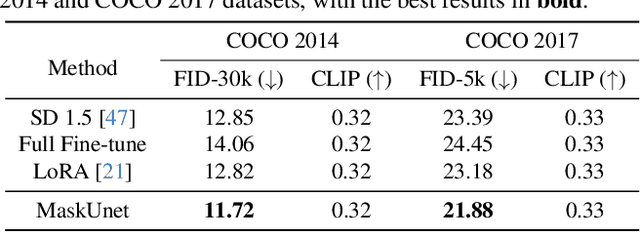
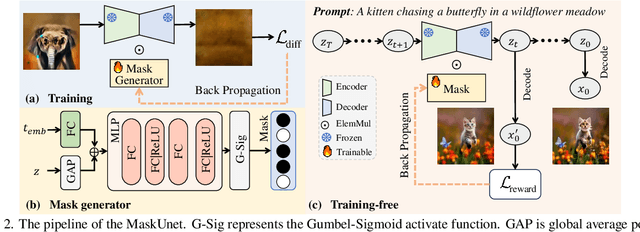
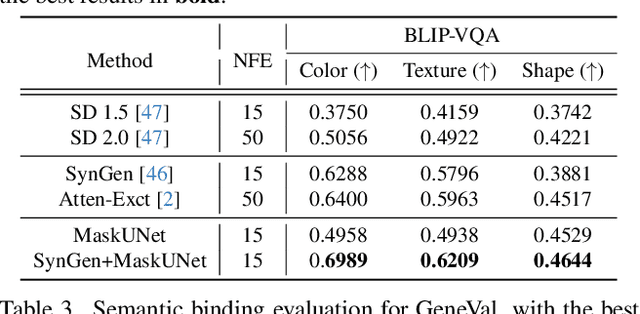
Abstract:The diffusion models, in early stages focus on constructing basic image structures, while the refined details, including local features and textures, are generated in later stages. Thus the same network layers are forced to learn both structural and textural information simultaneously, significantly differing from the traditional deep learning architectures (e.g., ResNet or GANs) which captures or generates the image semantic information at different layers. This difference inspires us to explore the time-wise diffusion models. We initially investigate the key contributions of the U-Net parameters to the denoising process and identify that properly zeroing out certain parameters (including large parameters) contributes to denoising, substantially improving the generation quality on the fly. Capitalizing on this discovery, we propose a simple yet effective method-termed ``MaskUNet''- that enhances generation quality with negligible parameter numbers. Our method fully leverages timestep- and sample-dependent effective U-Net parameters. To optimize MaskUNet, we offer two fine-tuning strategies: a training-based approach and a training-free approach, including tailored networks and optimization functions. In zero-shot inference on the COCO dataset, MaskUNet achieves the best FID score and further demonstrates its effectiveness in downstream task evaluations. Project page: https://gudaochangsheng.github.io/MaskUnet-Page/
WS-DETR: Robust Water Surface Object Detection through Vision-Radar Fusion with Detection Transformer
Apr 10, 2025Abstract:Robust object detection for Unmanned Surface Vehicles (USVs) in complex water environments is essential for reliable navigation and operation. Specifically, water surface object detection faces challenges from blurred edges and diverse object scales. Although vision-radar fusion offers a feasible solution, existing approaches suffer from cross-modal feature conflicts, which negatively affect model robustness. To address this problem, we propose a robust vision-radar fusion model WS-DETR. In particular, we first introduce a Multi-Scale Edge Information Integration (MSEII) module to enhance edge perception and a Hierarchical Feature Aggregator (HiFA) to boost multi-scale object detection in the encoder. Then, we adopt self-moving point representations for continuous convolution and residual connection to efficiently extract irregular features under the scenarios of irregular point cloud data. To further mitigate cross-modal conflicts, an Adaptive Feature Interactive Fusion (AFIF) module is introduced to integrate visual and radar features through geometric alignment and semantic fusion. Extensive experiments on the WaterScenes dataset demonstrate that WS-DETR achieves state-of-the-art (SOTA) performance, maintaining its superiority even under adverse weather and lighting conditions.
Free-Lunch Color-Texture Disentanglement for Stylized Image Generation
Mar 21, 2025



Abstract:Recent advances in Text-to-Image (T2I) diffusion models have transformed image generation, enabling significant progress in stylized generation using only a few style reference images. However, current diffusion-based methods struggle with fine-grained style customization due to challenges in controlling multiple style attributes, such as color and texture. This paper introduces the first tuning-free approach to achieve free-lunch color-texture disentanglement in stylized T2I generation, addressing the need for independently controlled style elements for the Disentangled Stylized Image Generation (DisIG) problem. Our approach leverages the Image-Prompt Additivity property in the CLIP image embedding space to develop techniques for separating and extracting Color-Texture Embeddings (CTE) from individual color and texture reference images. To ensure that the color palette of the generated image aligns closely with the color reference, we apply a whitening and coloring transformation to enhance color consistency. Additionally, to prevent texture loss due to the signal-leak bias inherent in diffusion training, we introduce a noise term that preserves textural fidelity during the Regularized Whitening and Coloring Transformation (RegWCT). Through these methods, our Style Attributes Disentanglement approach (SADis) delivers a more precise and customizable solution for stylized image generation. Experiments on images from the WikiArt and StyleDrop datasets demonstrate that, both qualitatively and quantitatively, SADis surpasses state-of-the-art stylization methods in the DisIG task.Code will be released at https://deepffff.github.io/sadis.github.io/.
InterLCM: Low-Quality Images as Intermediate States of Latent Consistency Models for Effective Blind Face Restoration
Feb 04, 2025


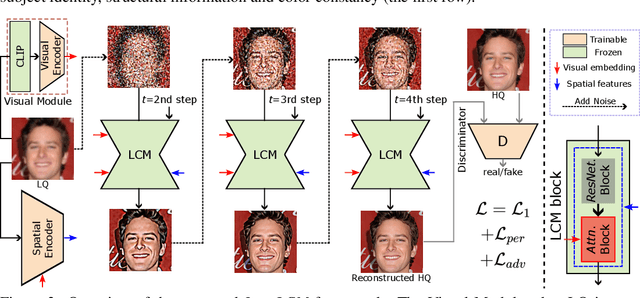
Abstract:Diffusion priors have been used for blind face restoration (BFR) by fine-tuning diffusion models (DMs) on restoration datasets to recover low-quality images. However, the naive application of DMs presents several key limitations. (i) The diffusion prior has inferior semantic consistency (e.g., ID, structure and color.), increasing the difficulty of optimizing the BFR model; (ii) reliance on hundreds of denoising iterations, preventing the effective cooperation with perceptual losses, which is crucial for faithful restoration. Observing that the latent consistency model (LCM) learns consistency noise-to-data mappings on the ODE-trajectory and therefore shows more semantic consistency in the subject identity, structural information and color preservation, we propose InterLCM to leverage the LCM for its superior semantic consistency and efficiency to counter the above issues. Treating low-quality images as the intermediate state of LCM, InterLCM achieves a balance between fidelity and quality by starting from earlier LCM steps. LCM also allows the integration of perceptual loss during training, leading to improved restoration quality, particularly in real-world scenarios. To mitigate structural and semantic uncertainties, InterLCM incorporates a Visual Module to extract visual features and a Spatial Encoder to capture spatial details, enhancing the fidelity of restored images. Extensive experiments demonstrate that InterLCM outperforms existing approaches in both synthetic and real-world datasets while also achieving faster inference speed.
Get What You Want, Not What You Don't: Image Content Suppression for Text-to-Image Diffusion Models
Feb 08, 2024
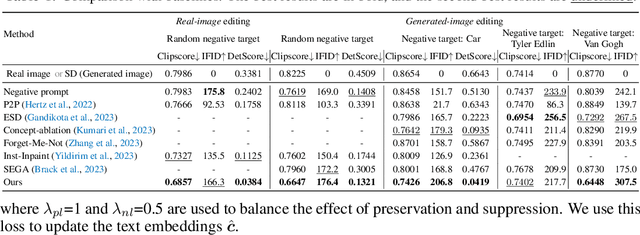
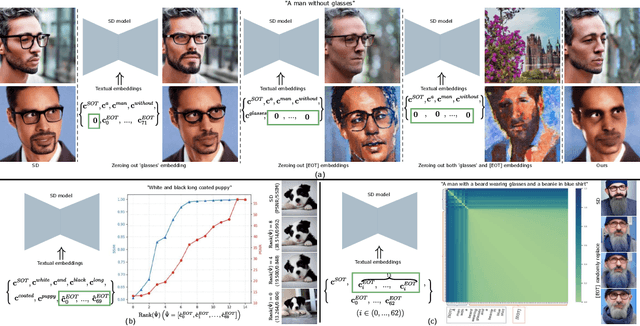

Abstract:The success of recent text-to-image diffusion models is largely due to their capacity to be guided by a complex text prompt, which enables users to precisely describe the desired content. However, these models struggle to effectively suppress the generation of undesired content, which is explicitly requested to be omitted from the generated image in the prompt. In this paper, we analyze how to manipulate the text embeddings and remove unwanted content from them. We introduce two contributions, which we refer to as $\textit{soft-weighted regularization}$ and $\textit{inference-time text embedding optimization}$. The first regularizes the text embedding matrix and effectively suppresses the undesired content. The second method aims to further suppress the unwanted content generation of the prompt, and encourages the generation of desired content. We evaluate our method quantitatively and qualitatively on extensive experiments, validating its effectiveness. Furthermore, our method is generalizability to both the pixel-space diffusion models (i.e. DeepFloyd-IF) and the latent-space diffusion models (i.e. Stable Diffusion).
Faster Diffusion: Rethinking the Role of UNet Encoder in Diffusion Models
Dec 15, 2023



Abstract:One of the key components within diffusion models is the UNet for noise prediction. While several works have explored basic properties of the UNet decoder, its encoder largely remains unexplored. In this work, we conduct the first comprehensive study of the UNet encoder. We empirically analyze the encoder features and provide insights to important questions regarding their changes at the inference process. In particular, we find that encoder features change gently, whereas the decoder features exhibit substantial variations across different time-steps. This finding inspired us to omit the encoder at certain adjacent time-steps and reuse cyclically the encoder features in the previous time-steps for the decoder. Further based on this observation, we introduce a simple yet effective encoder propagation scheme to accelerate the diffusion sampling for a diverse set of tasks. By benefiting from our propagation scheme, we are able to perform in parallel the decoder at certain adjacent time-steps. Additionally, we introduce a prior noise injection method to improve the texture details in the generated image. Besides the standard text-to-image task, we also validate our approach on other tasks: text-to-video, personalized generation and reference-guided generation. Without utilizing any knowledge distillation technique, our approach accelerates both the Stable Diffusion (SD) and the DeepFloyd-IF models sampling by 41$\%$ and 24$\%$ respectively, while maintaining high-quality generation performance. Our code is available in \href{https://github.com/hutaiHang/Faster-Diffusion}{FasterDiffusion}.
StyleDiffusion: Prompt-Embedding Inversion for Text-Based Editing
Mar 28, 2023



Abstract:A significant research effort is focused on exploiting the amazing capacities of pretrained diffusion models for the editing of images. They either finetune the model, or invert the image in the latent space of the pretrained model. However, they suffer from two problems: (1) Unsatisfying results for selected regions, and unexpected changes in nonselected regions. (2) They require careful text prompt editing where the prompt should include all visual objects in the input image. To address this, we propose two improvements: (1) Only optimizing the input of the value linear network in the cross-attention layers, is sufficiently powerful to reconstruct a real image. (2) We propose attention regularization to preserve the object-like attention maps after editing, enabling us to obtain accurate style editing without invoking significant structural changes. We further improve the editing technique which is used for the unconditional branch of classifier-free guidance, as well as the conditional one as used by P2P. Extensive experimental prompt-editing results on a variety of images, demonstrate qualitatively and quantitatively that our method has superior editing capabilities than existing and concurrent works.
 Add to Chrome
Add to Chrome Add to Firefox
Add to Firefox Add to Edge
Add to Edge